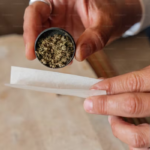Key Takeaways: Pre-Roll Manufacturing in Brief
- Strain Selection is Critical: Quality starts with choosing cannabis strains for aroma, potency, and burn consistency.
- Precision Processes: Every manufacturing step—grinding, filling, tamping, sealing—is carefully controlled for uniformity.
- Paper Choice Matters: Unbleached, organic hemp papers enhance taste, burn quality, and purity.
- Consistency Builds Trust: Automation ensures reliable size, potency, and burn across batches.
- Infused Options Boost Potency: Additions like hash oil or kief deliver stronger effects and richer flavors.
- Sustainability on the Rise: Eco-friendly materials and energy-efficient processes are becoming industry norms.
- Innovation Solves Scale Issues: Technology helps maintain quality and freshness in high-volume production.
- Lab Testing Ensures Safety: Rigorous quality checks and moisture control guarantee a safe product.
- Hand vs. Machine Rolled: Hand-rolled offers craft appeal; machine-rolled delivers consistency.
- Future is Personalized: Expect smart automation, eco-focus, and custom pre-roll options to dominate.
When you light up a premium pre-roll, it’s easy to overlook the meticulous care and sophisticated technology involved in its creation. How are these little masterpieces made? Let’s dive into the fascinating world of pre-roll manufacturing and uncover the secrets behind your favorite joints.
Cannabis Selection: Quality Starts Here
The journey to a perfect pre-roll begins long before the actual rolling process, starting with the careful and deliberate selection of cannabis strains. This isn’t just about picking any flower; it’s about a sophisticated understanding of cannabis genetics, cannabinoid profiles, and terpene compositions. Expert growers and procurement specialists work tirelessly to source flowers known for their exceptional aroma, precise potency, and, crucially, consistent burn characteristics.
The quality of the cannabis directly and significantly influences the user experience. A well-chosen strain ensures your pre-roll delivers the desired effects—whether it’s relaxation, euphoria, pain relief, or creativity—every single time. Factors like cultivation practices, harvest timing, and curing methods are also meticulously evaluated to ensure the cannabis is of the highest caliber, free from pesticides and heavy metals, and boasts an optimal moisture content for grinding and smoking. This initial, critical step sets the foundation for the entire manufacturing process, guaranteeing a premium product that meets consumer expectations for flavor, effect, and consistency.
Step-by-Step Pre-Roll Manufacturing Process
The creation of a pre-roll is a precise and carefully orchestrated dance of technology and technique.
Step 1: Grinding and Processing
The first technical step involves grinding and processing the selected quality flower. This seemingly simple step is, in fact, crucial for the pre-roll’s performance. The cannabis must be ground to achieve a perfectly uniform consistency. Commercial-grade grinders are employed for this purpose, designed to break down the flower without pulverizing it. The goal is to avoid extremes: if the cannabis is too coarse, it can lead to an uneven burn and difficult draw; if it’s too powdery, it can restrict airflow, making the pre-roll hard to smoke and potentially leading to a harsh experience. The ideal grind allows for smooth airflow, even burning, and a consistent release of cannabinoids and terpenes, contributing significantly to the overall smoking experience.
Step 2: Rolling Papers – More Than Just Wrapping
Rolling papers do far more than simply hold a pre-roll together—they shape the entire smoking experience. Premium brands choose high-quality, unbleached, organic hemp papers to deliver purity, slow, even burns, and minimal taste interference. These choices let the natural flavor of the cannabis take center stage, free from chemical residues or off-flavors. Some brands take it further by infusing papers with natural flavorings like fruit extracts or botanical terpenes, enhancing the strain’s aroma and taste. They also carefully select the paper’s porosity and thickness to fine-tune airflow and control the burn rate, ensuring a smoother, more satisfying session.
Step 3: Filling and Weighing
Once the cannabis is perfectly ground, the next critical stage is filling and weighing. This is where precision becomes paramount. State-of-the-art machinery is utilized to precisely weigh the ground cannabis and evenly distribute it into pre-formed rolling cones. This automated process ensures that every single pre-roll is consistent in both size and potency. This consistency is vital for delivering reliable effects with every smoke, allowing consumers to anticipate and trust the experience each time they light up a pre-roll from a reputable brand. Manual filling can lead to variations in density and weight, resulting in an inconsistent product. Modern machinery minimizes human error, guaranteeing uniformity across large batches.
Step 4: Shaping and Tamping
After filling, the cones undergo a process called tamping. This is a gentle but firm compression of the cannabis inside the cone. The primary purpose of tamping is to eliminate any air pockets that might have formed during the filling process. Proper tamping guarantees a consistent burn from start to finish and significantly enhances user satisfaction by preventing canoeing (when one side of the joint burns faster than the other) and ensuring a smooth, even draw. The pressure applied during tamping is carefully calibrated to achieve the ideal density – not too loose, which would burn too quickly, and not too tight, which would restrict airflow.
Step 5: Final Sealing and Inspection
The final steps in the primary manufacturing process involve final sealing and inspection. After tamping, the open end of the cones is twisted and sealed securely, preventing any spillage of the cannabis. This also helps maintain the pre-roll’s freshness. At this crucial stage, dedicated quality control experts meticulously inspect each joint. This inspection goes beyond just visual consistency; it includes checking for proper tightness, ensuring the seal is secure, and verifying weight accuracy against strict standards. Any pre-rolls that do not meet these rigorous specifications are rejected, guaranteeing that only the highest quality products make it to the market and ultimately into the hands of consumers.
Infused Pre-Rolls: Elevating the Experience
Infused pre-rolls enhance traditional joints by adding cannabis concentrates like hash oil, kief, or live rosin. Specialized machinery ensures precise, uniform application of these concentrates, boosting cannabinoid content for increased potency and enriching terpene profiles for amplified flavor and aroma. These premium products cater to consumers seeking a more intense or therapeutically targeted experience.
Sustainability in Pre-Roll Production
As environmental awareness grows, pre-roll manufacturers are prioritizing sustainability. This includes using biodegradable/recyclable packaging, organic papers, and energy-efficient equipment. They also focus on water conservation, responsible waste management, and ethical sourcing, demonstrating a commitment to both consumers and the planet.
Challenges and Innovations in Pre-Roll Manufacturing
Pre-roll manufacturing faces challenges in ensuring consistency, potency, and freshness. This requires meticulous monitoring of moisture, grind size, and density, along with rigorous testing for potency. To overcome these, the industry is embracing advanced automation technologies, including robotic arms, AI-powered sensors, machine vision, and precise climate control. These innovations streamline production, enhance efficiency, and elevate quality control.
Quality Assurance: The Key to Customer Trust
Quality assurance (QA) is fundamental for building customer trust. It involves comprehensive lab testing of raw cannabis for contaminants (pesticides, heavy metals, microbes) and accurate cannabinoid/terpene profiling. QA also includes precise moisture control, visual inspections, weight checks, and burn tests. Making batch-specific Certificates of Analysis (CoAs) available provides transparency and guarantees a safe, consistent product.
The Human Touch: Hand-Rolled vs. Machine-Rolled
The debate between hand-rolled and machine-rolled pre-rolls centers on artisanal appeal versus consistency. Hand-rolled joints offer a unique, crafted feel, appealing to those who value the human touch. Machine-rolled joints, however, excel in uniformity, efficiency, and predictable potency, producing identical products at high volumes. Ultimately, the choice depends on personal preference for craft versus consistency.
Future Trends in Pre-Roll Manufacturing
The industry is shifting toward:
- Smarter Automation: AI and machine learning will improve real-time quality control, optimize grind consistency, and ensure precise production.
- Eco-Friendly Innovations: Sustainability efforts will go beyond packaging, using renewable energy, compostable materials, and closed-loop systems.
- Personalized Pre-Rolls: Consumers will be able to customize cannabinoid profiles, terpenes, papers, and filters—both online and in-store.
Conclusion: Every Puff Counts
Each pre-roll represents a detailed process—from premium flower selection and precision grinding to sustainable packaging and advanced machinery. It’s a blend of innovation and craftsmanship designed to deliver a safe, consistent, and enjoyable experience with every puff.
FAQs: Pre-Roll Manufacturing
What defines a premium pre-roll?
Premium pre-rolls feature high-grade flower, uniform grind, unbleached hemp papers, and precise filling for smooth, consistent burns. They’re lab-tested and undergo strict quality checks.
How is the cannabis prepared?
Producers grind the cannabis to a consistent texture—not too coarse or too fine—using commercial-grade grinders. This process ensures an even burn and smooth airflow.
Why are rolling papers important?
They influence flavor and burn. Premium pre-rolls often use organic, unbleached hemp papers for a clean, slow, and even smoke.
What’s the difference between regular and infused pre-rolls?
Regulars contain only flower; infused ones include concentrates like kief or live rosin, boosting potency and enhancing flavor.
How is consistency ensured?
Manufacturers use precise machinery for filling, tamping, and sealing, plus weight checks and visual inspections to maintain uniformity.
Hand-rolled vs. machine-rolled – which is better?
Hand-rolled offers a personal touch; machine-rolled ensures consistency and efficiency — ideal for large-scale production.
How is safety guaranteed?
Products are lab-tested for contaminants and cannabinoid content. Moisture control and proper packaging protect freshness and safety.
What about sustainability?
Eco-friendly brands use recyclable packaging, unbleached papers, and energy-efficient production, focusing on waste reduction and sustainable sourcing.
What’s next for pre-rolls?
Expect more automation, greener practices, and customizable pre-rolls tailored to user preferences in effect, flavor, and design.





